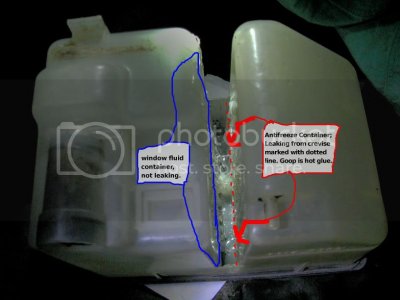Does anyone know whether the coolant reservior (overflow tank) is pressurized or not? In other words, does it vent to ambient air pressure, or is it sealed up to some pressure point? I have an '90 Bronco 4X4 with the 5.8 liter engine, Eddir Bauer Edition; however, I think a broad range of years and models use the same overflow tank.
The reason for this question stems from a coolant leak that keeps appearing on the fender underneath the coolant tank. I can feel the coolant dripping from the bottom of the tank after the engine has been running a while. I'm pretty sure it hasn't been coming from the hose and ******. (Earlier, I had a problem with it sloshing occasionally from the refill cap. The cap had become loose. So I fixed that.)
In an effort to find the new leak, I removed the tank and submerged it in some water. The refill cap was oriented at the bottom of the water, and the hose ****** at the top. When air pressure was appled through the hose connection, then, sure enough, bubbles came out of an area pictured here:

Note the messy hot glue I've added to the area that was formerly "leaking" air. This was done in haste -- after I saw the air bubbles. Now nothing leaks, but it has since occurred to me that perhaps the "patched" area is actually supposed to let air out. Hence my question about the pressure.
The tank seems to be made of polyethylene, which is difficult if not impossible to glue. Nevertheless, the hot glue that was used to plug the air "leak" seems to be adherring -- for the time being. But I could probably peel it back off, if it turns out that I shouldn't have plugged that area. Then I'll still be left with a leak. And after the area pictured was sealed, there were no more air leaks, so I am assuming the coolant drip was somehow coming from that area, though it's at the top of the tank, and I haven't overfilled the tank.
Anyway, is that tank supposed to be pressurized or breathable?
The reason for this question stems from a coolant leak that keeps appearing on the fender underneath the coolant tank. I can feel the coolant dripping from the bottom of the tank after the engine has been running a while. I'm pretty sure it hasn't been coming from the hose and ******. (Earlier, I had a problem with it sloshing occasionally from the refill cap. The cap had become loose. So I fixed that.)
In an effort to find the new leak, I removed the tank and submerged it in some water. The refill cap was oriented at the bottom of the water, and the hose ****** at the top. When air pressure was appled through the hose connection, then, sure enough, bubbles came out of an area pictured here:

Note the messy hot glue I've added to the area that was formerly "leaking" air. This was done in haste -- after I saw the air bubbles. Now nothing leaks, but it has since occurred to me that perhaps the "patched" area is actually supposed to let air out. Hence my question about the pressure.
The tank seems to be made of polyethylene, which is difficult if not impossible to glue. Nevertheless, the hot glue that was used to plug the air "leak" seems to be adherring -- for the time being. But I could probably peel it back off, if it turns out that I shouldn't have plugged that area. Then I'll still be left with a leak. And after the area pictured was sealed, there were no more air leaks, so I am assuming the coolant drip was somehow coming from that area, though it's at the top of the tank, and I haven't overfilled the tank.
Anyway, is that tank supposed to be pressurized or breathable?
Last edited by a moderator:
